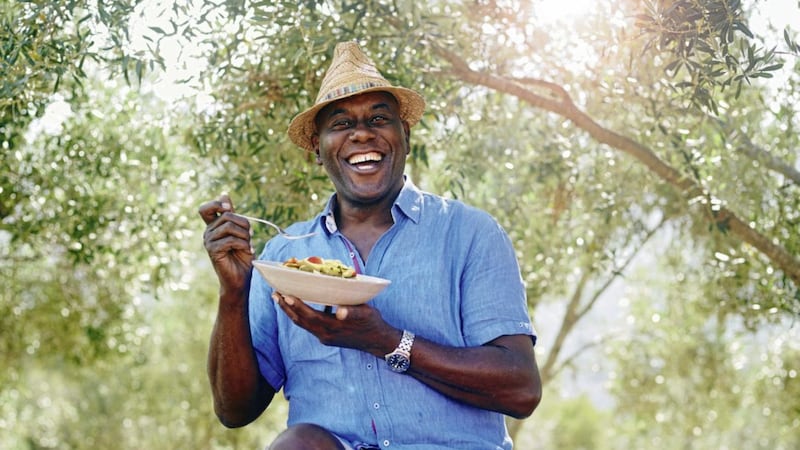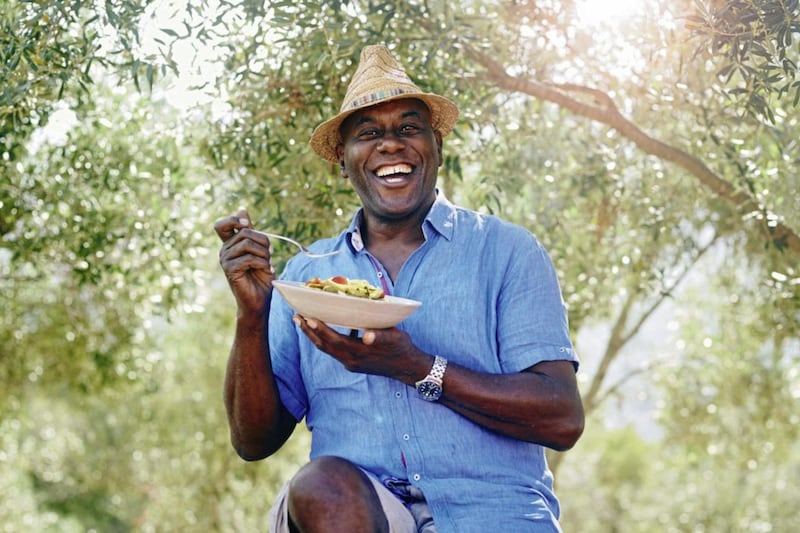HAS there ever been a happier man on TV? Ainsley Harriott, with his broad smile and infectious laugh, was a mainstay in living rooms for years on Ready Steady Cook and Can't Cook, Won't Cook back in the 90s and noughties, and at 63 he's as cheerful as ever.
"I have a young heart," he says. "I love energy, I love to give people energy, I love to feed off energy – it makes me happy. I don't think of age as a barrier."
He even thinks it's hilarious that he became an accidental meme star after an appearance on This Morning in 2018, which saw him surprising a slightly overwhelmed elderly woman at her home with the announcement of: 'Why, helloooo Jill...!'
"It's great fun – all the kids what to know who I am! People leave notes on my car [saying], 'Why hello Jill'," he says, laughing. "Why not have a bit of banter with people?"
The cook and presenter took some time out the spotlight after the height of his fame but has had a late resurgence with recent TV shows Ainsley's Caribbean Kitchen and, his newest offering, Ainsley's Mediterranean Cookbook.
"It felt close to home," he says of the food of the Med. "There's a familiarity, being trained as a French chef all those years ago. It's a wonderful melting pot of cultures.
"Everybody has their own identity, but what comes across stronger than ever is how people are passionate about local produce, about where their food comes from – and the closer it is, the better."
He also loves the Sardinian way, for example, of "taking simple ingredients and not messing about with them too much. It's cleaner, more rewarding, they've been kissed by the sun so they don't tend to over-refrigerate – which is what we do here."
The new series sees Harriott travel to regions linked by the Mediterranean sea, from the French island of Corsica, and Sardinia and Andalucia to the coast of Morocco and Jordan. "We still don't know much about the Middle East," he muses. "There's a softness and a lightness about the people [of Jordan]."
He regales stories of the food producers he met; a former rugby player in Corsica who now runs his family's olive oil business, a Granadian man who used to be fit before he opened a deli with his wife and now spends all day tasting Iberico ham and breads – "No wonder he had a happy smile on his face" – or de-stoning a mountain of dates to make molasses in a family home in Jordan.
"But what's really special is they take the date stones and dry them out and make them into coffee – just fantastic!"
The accompanying book is packed with recipes he picked up along the way, or inspired by the produce and people he met; seafood paella from Andalucia or harissa lemon chicken skewers with aubergine from Morocco.
He learned how to make "wonderful pasta using a cheese grater" and served it with a sausage and fennel sauce.
It's classic fare, yes, but crucially doable for most people at home. "I'm not here to try and take food and twist it up and do lots of different things to it. Classics are classics, and I don't think we should hide away from that," he says,
"People know that when they watch an Ainsley programme or get an Ainsley book it's going to be something that is approachable and something that is achievable and ultimately something that is rewarding."
This is food, he says, that's easy to understand and easy to get hold of: "How beautiful is it that we have those ingredients on our doorstep that we didn't have before?"
There's a chapter dedicated to vegan and vegetarian food – so is he consciously eating less meat these days himself? "Yes," Harriott says, tentatively. "I grew up with a meat and veg type of attitude in this country. [But now] I think we have more availability now and more choice when it comes to vegetarian and vegan food – its far more exciting on the plate."
In the book, he celebrates this with the likes of squash and sweet potato tagine with lemon and pistachio couscous inspired by the produce of Morocco, or a ricotta, courgette, lemon and mint tart from Corsica.
The Mediterranean diet is often touted as being one of the healthiest in the world, but while there's incredible seafood, fresh veg and olive oil aplenty, Harriott adds that "obesity is everywhere, don't kid yourself".
Mediterranean markets are where the real magic happens, he says. "You get a real sense of community, you see the real people in the market and the way they interact with each other, the kids running around, the grandad sitting chewing on a piece of straw – it gives him a reason to get up in the morning, to sit in that chair and watch the world go by, instead of sitting at home watching Tipping Point.
"Which I do like to do occasionally," Harriott adds, with a hearty belly laugh.
:: Ainsley's Mediterranean Cookbook by Ainsley Harriott, photography by Dan Jones, is published by Ebury Press, priced £20. Below are two recipes from the book for you to try.
SEA BASS AND POTATO BAKE
(Serves 4)
4 sea bass fillets, skin on
2 lemons: 1 thinly sliced, 1 for squeezing
4 large waxy potatoes (Desiree work well), peeled and thinly sliced
1 red onion, thinly sliced
2 large tomatoes, thinly sliced
1 large garlic clove, finely chopped
2tbsp olive oil
120ml white wine
2 bay leaves
3 thyme sprigs
3tbsp chopped fresh flat-leaf parsley
2tsp fresh marjoram or oregano leaves
Sea salt and freshly ground black pepper
Fresh bread, to serve
Method:
Preheat the oven to 200C/180°C fan. Line an oven-proof dish with baking parchment. Season the fish fillets with salt and pepper and squeeze over a little lemon juice. Set aside.
Layer the potatoes and onions in the bottom of the lined dish, season well with salt and black pepper, then add a layer of tomatoes.
Sprinkle over the garlic, then place a few lemon slices on top. Drizzle over the oil, squeeze over some more lemon juice and pour in the wine. Add the bay leaves and thyme sprigs, two tablespoons of the parsley and sprinkle over half of the marjoram leaves. Season well with salt and pepper, cover with foil and bake for 25-30 minutes.
Remove the dish from the oven and lay the fish fillets in the dish skin-side up. Sprinkle with the remaining marjoram and bake uncovered for a further 12-14 minutes or until the fish is cooked through (it should flake easily when cooked). Use a spatula or fish slice to carefully remove the fish from the dish, cover loosely with foil, and keep warm.
Return the vegetables to the oven to bake for a further four to five minutes (if needed) until the potatoes turn golden brown in places. Remove from the oven and serve immediately, scattered with the remaining fresh parsley, with some fresh bread on the side.
PLUM FRANGIPANE TART
(Serves 6 - 8)
For the pastry:
200g plain flour, plus extra for dusting
2tbsp icing sugar
100g cold unsalted butter, diced
1 medium egg
2-3tsp cold water
For the frangipane:
100g unsalted butter
100g caster sugar
2 large eggs
55g plain flour
70g ground almonds
A drop of almond essence
To assemble:
100g plum jam
3-4 plums, stone removed, cut into thin wedges
Method:
First, make the pastry. Sift the flour and icing sugar into a large bowl. Add the butter and rub it in with your fingertips until the mixture resembles fine breadcrumbs. Make a well in the centre and add the egg and two teaspoons of cold water. Stir, combining the dry ingredients into the wet, adding another teaspoon of water if necessary.
When the pastry starts to come together, gently knead into a smooth ball. Cover the pastry with cling-film and chill in the fridge for at least 15 minutes.
Meanwhile, preheat the oven to 200C/180C fan. Unwrap the chilled pastry, place on a lightly floured work surface and roll out to about 3mm thick.
Line a 23cm diameter loose-bottomed tart tin with the pastry, leaving a little excess pastry hanging over the edges. Line the pastry case with a sheet of baking parchment and fill with baking beans or raw rice.
Bake blind for 12-15 minutes, until the pastry is dry to the touch, then remove the parchment and baking beans and return the pastry case to the oven for a further five minutes until it is very lightly coloured. Use a small, sharp knife to trim away the excess pastry from the edges and then leave the pastry case to cool slightly while you prepare the filling.
Reduce the oven temperature to 180C/160C fan. To make the frangipane, beat the butter and sugar together in a large bowl until light and fluffy, then beat in the eggs one at a time. Stir in the flour, ground almonds and almond extract. Spread the jam over the base of the pastry case, then top with the frangipane.
Smooth the surface with a spatula or back of a spoon, then push the plum slices onto the surface of the frangipane, arranging them in an attractive pattern. Bake for 25-30 minutes until the filling is golden and well risen. Leave to cool in the tin before slicing.








